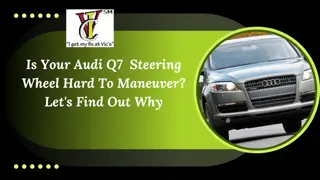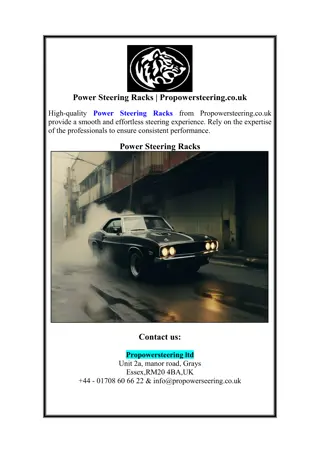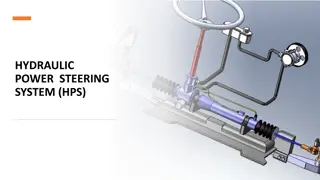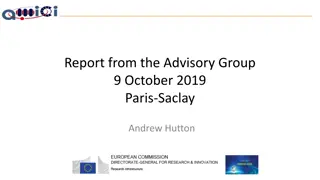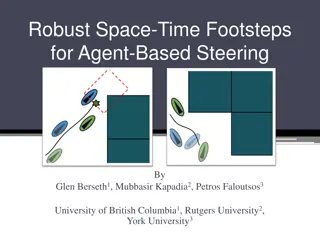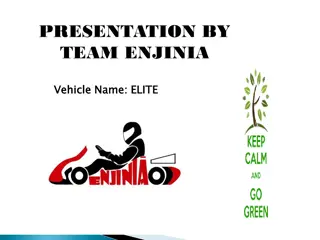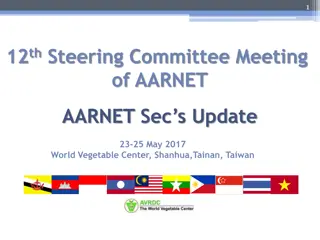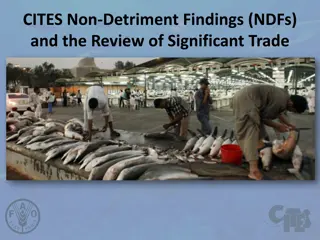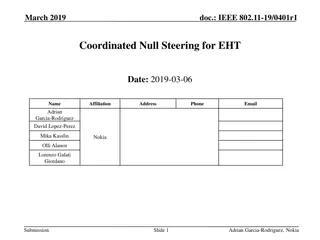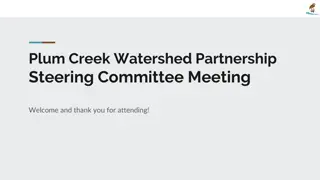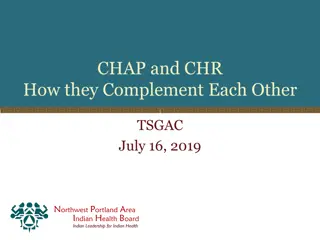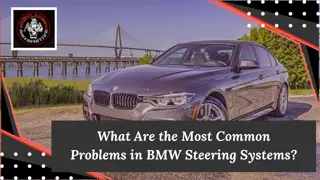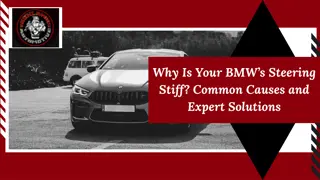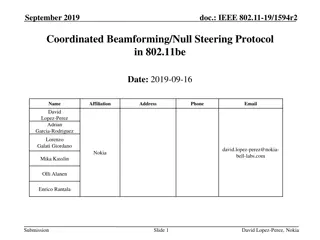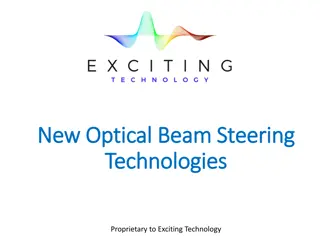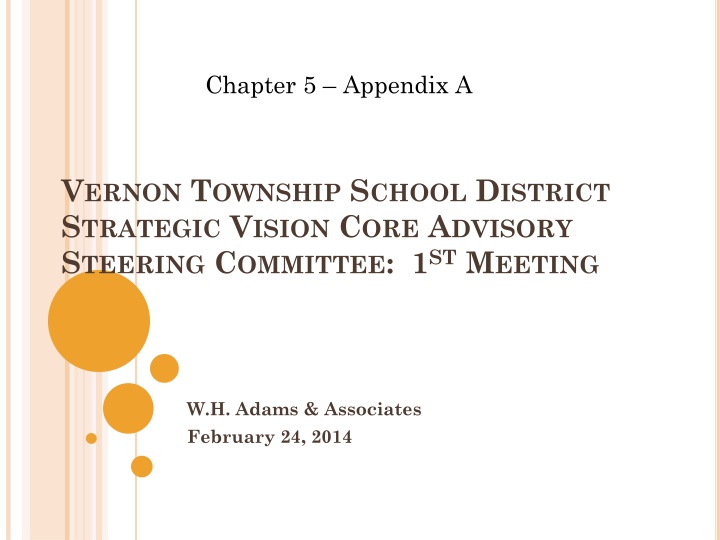
Strategic Visioning Process for Vernon Township School District
Explore the strategic visioning process undertaken by the Vernon Township School District, including key steps like stakeholder input, goal identification, and data analysis to create a desirable future for the organization. Challenges such as declining enrollment and changing demographics are addressed, emphasizing the importance of commitment to the visioning process and ongoing communication through platforms like blogs.
Download Presentation

Please find below an Image/Link to download the presentation.
The content on the website is provided AS IS for your information and personal use only. It may not be sold, licensed, or shared on other websites without obtaining consent from the author. If you encounter any issues during the download, it is possible that the publisher has removed the file from their server.
You are allowed to download the files provided on this website for personal or commercial use, subject to the condition that they are used lawfully. All files are the property of their respective owners.
The content on the website is provided AS IS for your information and personal use only. It may not be sold, licensed, or shared on other websites without obtaining consent from the author.
E N D
Presentation Transcript
Chapter 5 Appendix A VERNON TOWNSHIP SCHOOL DISTRICT STRATEGIC VISION CORE ADVISORY STEERING COMMITTEE: 1STMEETING W.H. Adams & Associates February 24, 2014
AGENDA Introductions Brief Review of Visioning & Planning Process Purpose Take Blinders Off Presentation of the Literature Suggested Premises to Consider for Vision Creation Areas for Consideration Look to the Future, Futurist Theories, & the Future of Learning Whole Child Approach to Education Partnership for 21st Century Skills
AGENDA CONTINUED. PROMOTE ONLINE SURVEY Lock-in April Meeting Dates: Two Meetings Week of April 7: (Either Monday & Tuesday or Thursday and Friday) Two Meetings Week of April 14 Note: Spring Break is April 18 25, 2014
HOUSEKEEPING Commitment to the Process This is a PROCESS. Respect for everyone s input both in person and online Blog Minutes Taken
TAKEA LOOKAT THIS Dog-Bot-345.jpg
SOMEOFTHE CHALLENGES Declining Enrollment Declining Resources Cost Per Pupil Changing Demographics Changing Community Needs Facilities Other
STRATEGIC VISION DEFINITION The process requires the systematic creation of visions of a desirable future for an organization or an individual. Typically, this procedure starts with a review of past events and the current situation, moves on to envision desirable futures, and concludes with the identification of specific ways to move toward the desired future. A visioning procedure often prepares the way for more formal goal setting and planning. World Future Society, 2012
STRATEGIC VISIONING: TEN STEPS Board & Leader -ship Team Presentation of Results Stakeholder Input * Surveys of Stakeholders for perceptions of district's strengths, weaknesses, opportunities & threats Steering Committee Identifies Target Areas & Goals Collect Review and Analyze Data Steering Committee Reviews Data And Develops Vision * Present, Discuss & Customize Model *Interview Board Members * Identify Steering Committee Core Committee Blog for Ongoing Communication 8
STRATEGIC VISIONING: TEN STEPS Action Teams Prioritize Goals & Develops 1-2 Year Action Plans District Team Review & Follow-up Steering BOE Review, Input, Modification and Approval Stakeholder & Community Announcement Committee Review Plans & Make Recommendations Core Committee Blog for Ongoing Communication 9
PRESENTATIONOF PREMISESFOR CONSIDERATION: CEREBRAL The Futurists The World Future Society (40+ years, www.wfs.org) Whole Child Approach to Education ASCD (formerly the Association for Supervision and Curriculum Development, started 1943, www.ascd.org) Crafting the Future of Learning Knowledge Works Foundation (10+ years, www.knowledgeworks.org) Partnership for 21st Century Skills P21 Founded 2002 www.p21.org
A LOOKINTOTHE FUTURE Creating the Future Vision for Learning
WORLD FUTURE SOCIETY: KNOWN GLOBAL TRENDS 1. Population growth slows and people are getting older. 2. The point of gravity in the global economy switches from Western economies to emerging markets. 3. Our economies and culture are getting more globalized. 4. The growing impact of emerging economies will lead to economic reforms in those countries, but without taking over Western values completely.
WORLD FUTURE SOCIETY: KNOWN GLOBAL TRENDS 5. The world will be more and more urbanized. 6. Population growth and our economy will continue to put pressures on the environment, energy supplies, soils, biodiversity, water and food supplies. 7. Technological innovation will change our lives radically. But we don t know how and in which ways.
MOORES LAW The technology at the leading edge changes so rapidly that you have to keep current after you get out of school. Gordon Moore.
MOORES LAW (DOUBLINGEVERY 18 MONTHS!) Year RAM Storage Speed Cost 1979 8K 128K 2MHz $5,000 1984 128K 400K 10MHz $3,900 2010 2GB 350GB 2.5Hz $400 2022 208TB 40TB 1.2THz $1.37 1024K = 1MB 1024MB = 1GB 1024GB = 1TB Jukes, 2010
MOORES LAW (DOUBLINGEVERY 12 MONTHS!) Year RAM Storage Speed Cost 2010 2 GB 350 GB 2.5 GHz $400 2018 2,097,152 GB 209,715,200 GB 524,288,000 GHz 3 cents 1024K = 1MB 1024MB = 1GB 1024GB = 1TB Jukes, 2010
THE FUTURE POWER INDUSTRY Manufacturing power generation units the size of ac units will go into full production. Installation crews will begin to work around the clock. The entire national grid will need to be taken down (a 20 year project). Much of it will be recycled and the recycling process alone will employ many thousands of people. Micro-grid operations will open in every community requiring a new breed of engineers, managers, and regulators. 17
THE FUTURE AUTO TRANSPORTATION GOING DRIVERLESS The first wave of driverless vehicles will be luxury vehicles that allow you to kick back, listen to music, have a cup of coffee, stop wherever you need to along the way, stay productive in transit with connections to the Internet, make phone calls, and even watch a movie or two, for substantially less than the cost of today s limos. Driverless technology will initially require a driver, but it will quickly creep into everyday use much as airbags did. First as an expensive option for luxury cars, but eventually it will become a safety feature stipulated by the government. The greatest benefits of this kind of automation won t be realized until the driver s hands are off the wheel. With over 2 million people involved in car accidents every year in the U.S., it won t take long for legislators to be convinced that driverless cars are a substantially safer and more effective option. 18
THE FUTURE AUTO TRANSPORTATION GOING DRIVERLESS Delivery dispatchers Traffic monitoring systems, although automated, will require a management team. Automated traffic designers, architects, and engineers Driverless ride experience people. Driverless operating system engineers. Emergency crews for when things go wrong. 19
THE FUTURE: BOTS Jobs Going Away Fishing bots will replace fishermen. Mining bots will replace miners. Ag bots will replace farmers. Inspection bots will replace human inspectors. Warrior drones will replace soldiers. Robots can pick up building material coming out of the 3D printer and begin building a house with it. New Jobs Created Robot designers, engineers, repairmen. Robot dispatchers. Robot therapists. Robot trainers. Robot fashion designers. 20
THE FUTURE: SHOPPING ON DEMAND SHOPPING! 3-D PRINTER IN EVERY HOME New Jobs Created * 3D printer design, engineering, and manufacturing * 3D printer repairmen will be in big demand * Product designers, stylists, and engineers for 3D printers 21 * 3D printer Ink sellers
WILLITOR CAN IT HAPPENIN VERNON?
SOME THOUGHTS. Certainly there s a downside to all this. The more technology we rely on, the more breaking points we ll have in our lives. Driverless drones can deliver people. These people can deliver bombs or illicit drugs as easily as pizza. Robots that can build building can also destroy buildings. All of this technology could make us fat, dumb, and lazy, and the problems we thought we were solving become far more complicated. We are not well-equipped culturally and emotionally to have this much technology entering into our lives. There will be backlashes, destroy the robots or damn the driverless car campaigns with proposed legislation attempting to limit its influence. Thomas Frey 23
SAMPLEOF 21ST CENTURY SKILLSAND FUTURISTS Living on the Future Edge: Windows on Tomorrow. (2010) Ian Jukes, Ted McCain, Lee Crockett Teaching Digital Natives: Partnering For Real Learning. (2010) Marc Prensky The Singular Is Near (2005) Ray Kurzweil The World Future Society, www.wfs.org The Partnership for 21st Century Skills, www.p21.org 24
THE WHOLE CHILD APPROACH Each child, in each school, in each of our communities deserves to be healthy, safe, engaged, supported, and challenged. That's what a whole child approach to learning, teaching, and community engagement really is. ASCD, (2013). http://www.wholechildeducation.org/
WHOLE CHILD: HEALTH Each student enters school healthy and learns about and practices a healthy lifestyle. Research confirms that students do better in school when they are emotionally and physically healthy. They miss fewer classes, are less likely to engage in risky or antisocial behavior, concentrate more, and achieve higher test scores. ASCD, (2013). http://www.wholechildeducation.org/
WHOLE CHILD: SAFE Each student learns in an environment that is physically and emotionally safe for students and adults. Feeling safe at school translates into higher academic achievement, increased student well- being, and greater engagement. Children who don't feel safe can't concentrate on their studies, don't connect with their classmates, or don't go to school at all. ASCD, (2013) http://www.wholechildeducation.org/
WHOLE CHILD: ENGAGED Each student is actively engaged in learning and is connected to the school and broader community. To learn at their best, students must be engaged and motivated. Substantial research shows that students who feel both valued by adults and a part of their schools perform better academically and also have more positive social attitudes, values, and behavior. After-school (and in- school) programs can promote academic achievement, but their success requires targeted investment, stakeholder commitments, focused academic support, quality programming, and a process of continual improvement. ASCD, (2013). http://www.wholechildeducation.org/
WHOLE CHILD: SUPPORT Each student has access to personalized learning and is supported by qualified, caring adults. In addition to improving students' academic performance, research shows that supportive schools also help prevent a host of negative consequences, including isolation, violent behavior, dropping out of school, and suicide. Central to a supportive school are teachers, administrators, and other caring adults who take a personal interest in each student and in the success of each student. http://www.wholechildeducation.org/ ASCD, (2013).
WHOLE CHILD: CHALLENGED Each student is challenged academically and prepared for success in college or further study and for employment and participation in a global environment. To succeed in college, other postsecondary education, and the workplace, students need higher-level thinking, communications, and problem-solving skills as well as knowledge of the world and its people. These are all products of a curriculum that challenges students to work harder as they investigate a wide range of real-world subjects. ASCD, (2013). http://www.wholechildeducation.org/
WHOLE CHILD: SUSTAINABILITY Schools using a whole child approach use collaboration, coordination, and integration to ensure the approach's long-term success. Policies and practices, from professional development to the school master schedule to community partnerships, must reflect the central effort to ensure each child is healthy, safe, engaged, supported, and challenged. http://www.wholechildeducation.org/ ASCD, (2013).
BRIDGINGTHE FUTURETOTHE PRESENT CHILD Sunrise 11/5/2013 First day residents can return to LBI after Sandy
Review of 21st Century Fluencies Solution Fluency Solution Fluency Information Fluency Creativity Fluency Digital Citizen Collaboration Fluency Media Fluency Creative Fluency Media Fluency Collaboration Fluency Information Fluency JUKES, 2010
SOLUTION FLUENCY Solution Fluency: thinking creativity and problem-solving skills applied in real time. Solution fluency is at the core of just-in-time learning. This is about whole-brain Source: Jukes, I., McCain T., & Crockett, L. (2010). Living on the Future Edge. Kelowna BC, Canada: 21st Century Fluency Project and Corwin Press, p. 115-116.
CREATIVITY FLUENCY Creativity Fluency: The process by which artistic proficiency adds meaning through design, art, and storytelling. It is no longer enough to have functional product. Creative fluency extends beyond visual creative skills to using the imagination to create stories, and to create products which tell stories. Source: Jukes, I., McCain T., & Crockett, L. (2010). Living on the Future Edge. Kelowna BC, Canada: 21st Century Fluency Project and Corwin Press, p. 115-116.
COLLABORATION FLUENCY Collaboration Fluency: proficiency that has reached the subconscious ability to work cooperatively with virtual and real partners in an online environment to create original digital products. The teamworking Source: Jukes, I., McCain T., & Crockett, L. (2010). Living on the Future Edge. Kelowna BC, Canada: 21st Century Fluency Project and Corwin Press, p. 115-116.
MEDIA FLUENCY Media Fluency: There are two components to media fluency. The first component is the ability to look analytically at any communication media to interpret the real message, determine how the chosen media is being used to shape thinking, and evaluate the efficacy of the message. The second component is the ability to create and publish original digital products, matching the media to the intended message by determining the most appropriate and effective media for that message. Source: Jukes, I., McCain T., & Crockett, L. (2010). Living on the Future Edge. Kelowna BC, Canada: 21st Century Fluency Project and Corwin Press, p. 115-116.
INFORMATION FLUENCY Information Fluency: There are two parts to information fluency. Being able to access raw information from the most appropriate high-tech and low-tech sources is the first part. This may be from a textbook, but may just as easily be a cell phone, wiki, social network, other digital or nontraditional source. Secondly, information fluency is the ability to critically evaluate the data. Information fluency is also the ability to determine bias in the information we retrieve, assessing the accuracy of the data by analyzing the methodology of how it was gathered and cross-referencing it to multiple sources that verify and support the specific information that is found. Source: Jukes, I., McCain T., & Crockett, L. (2010). Living on the Future Edge. Kelowna BC, Canada: 21st Century Fluency Project and Corwin Press, p. 115-116.
P21 FRAMEWORK: FRAMEWORKFOR 21ST CENTURY LEARNING
CENTRAL (GREEN): CORE SUBJECTS (3R S) AND 21ST CENTURY THEMES Core subjects: English Reading or language arts World languages Arts Mathematics Economics Science Geography History Government and civics
21ST CENTURY THEMES Schools must promote an understanding of academic content at much higher levels by weaving 21st century interdisciplinary themes into core subjects: Global Awareness Financial, Economic, Business and Entrepreneurial Literacy Civic Literacy Health Literacy Environmental Literacy
LEARNINGAND INNOVATION SKILLS (ORANGE): 4 C S Learning and innovation skills are what separate students who are prepared for increasingly complex life and work environments in today s world and those who are not. They include: Creativity and Innovation Critical Thinking and Problem Solving Communication and Collaboration
INFORMATION, MEDIA, AND TECHNOLOGY SKILLS (BLUE) Information Literacy Access and Evaluate Information Use and Manage Information Media Literacy Analyze Media Create Media Products ICT (Information, Communication, Technology) Literacy Apply Technology Effectively
LIFE & CAREER SKILLS (RED) Flexibility and Adaptability Adapt to Change Be Flexible Initiative and Self-Direction Manage Goals and Time Work Independently Be Self Directed (Learners) Social and Cross-Cultural Skills Interact Effectively with Others Work Effectively in Diverse Teams Productivity and Accountability Manage Products Produce Results Leadership and Responsibility Guide and Lead Others Be responsible to others
CREATINGTHE FUTUREFOR LEARNING 2020 Forecast: Creating the Future of Learning Published by Knowledge Works Foundation & the Institute for the Future & Knowledge Works Forecast 3.0: Recombinant Education: Regenerating the Learning Ecosystem
FROM KNOWLEDGE WORKS FORECAST 3.0 changes point the way toward a diverse learning ecosystem in which learning adapts to each child instead of each child trying to adapt to school. ILP Individual Learning Plan. W.H. Adams & Associates
2020 FORECAST: CREATINGTHE FUTUREOF LEARNING FOCUSON SIX DRIVERSOF CHANGE Drivers of change are defined as major forces of transformation that will drive our efforts to remake learning and schools over the next 10 years.
SIX DRIVERSOF CHANGE Self Organizations Systems Society Economy Knowledge
EXAMPLE: KNOWLEDGE DRIVEROF CHANGE & TRENDS An extremely visible world demands new sense making. The authors discussed how the continuing proliferation of information will further burden families, learners, educators, and decision makers to make sense out of the excessive amount of data that will be available. Forecasters suggest the need for new tools for examining data that will require new skills and understanding. Questions for educators: 1) How do ubiquitous, visible data impact teaching, learning, and the assessment of learning experiences? 2) How can we use data to enhance human decisions rather than to automate them?
KNOWLEDGE TRENDS Personal metrics Visual Literacy Open Source Assessment Games as Practice Metaverse blended digital-physical realities that are used to create new learning geographies.

